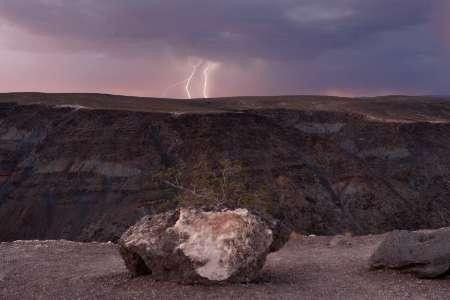Scientists Solve the Mystery Of The 'Sailing Stones' At Death Valley National Park (Watch Video)
The Rocks Have Been Observed to Move Mysteriously Across a Dry Lake Bed

The mystery of the Death Valley's "sailing stones" has existed since ages; it has intrigued scientists and laymen alike on how hundreds of lifeless rocks slide mysteriously across a dry lake bed Racetrack Playa in Death Valley, California. Scientists have conducted researches and investigations in this place since the 1940s.
The dry bed has gotten its name Racetrack Playa because of the mysteriously moving rocks that leave trails. This has boggled the minds of researchers since some of the rocks are extremely heavy, weighing about 320 kilograms. The mystery behind this phenomenon has finally been solved by paleobiologist, Richard D. Norris the Scripps Institution of Oceanography and his team.
To find a reasonable explanation for this, the team placed a few rocks on the river bed in 2011 and kept it under observation. The rocks were monitored by a high resolution weather station. Most of the time the rocks would not move for decades and researchers thought it would take years to see a change -- but they were surprised to see that the rocks moved just two years later after the experiment began, in 2013. Dr. Norris stated that it was complete "dumb luck." He is also the lead author of the paper on the solved mystery in the PLOS One journal.
"It's a very rare phenomenon," said Norris. The reasons behind this strange occurrence was not the wind or the ice, which was previously thought to be the likely causes. They were sure of this because the rocks placed on the playa were brought from the outside and because they had embedded special global positioning system devices, designed by his cousin and co-author, James Norris.
In December 2013, before the rocks started moving, they discovered that there were several series of events that set the rock in motion. The playa is usually dry and when it rains, the rainwater from the mountains fill part of it. This accumulation of water forms a pond, which is around 7 inches deep; overnight the temperature is freezing and researchers said that this causes the water to form ice. What then happens is that in the morning, when the weather is warm, this thin sheet of ice that was formed starts cracking and a light breeze makes them move across the lake bed. They then push against the rocks and nudge them, causing them to move and leave trails on the soft mud.
The ice, explained Norris, is barely an eighth of an inch thick, it is thin yet it moves freely and strongly. He further explained that this phenomenon occurs when the days are warm and the nights are extremely cold.
"On Dec. 21, 2013, ice breakup happened just around noon, with popping and cracking sounds coming from all over the frozen pond surface," he described.
The rocks move in the wind at the speed of three to five meters per minute, all because of the underlying ice that is just three to five millimeters thick. The phenomenon goes on from a few seconds to about 16 minutes in some cases.
This theory holds good, but researchers say they the mystery is only partially solved as they had placed small rocks and have not understood how the heavier rocks move. They have also suspected that climate change may be affecting the sailing rocks. They also noticed that some rocks moved 60 meters in just one motion. The last time this motion was observed was in 2006 and researchers think that climate change has affected the formation of ice and so the frequency of this event has reduced.
Source: YouTube/Kalm Bach




















